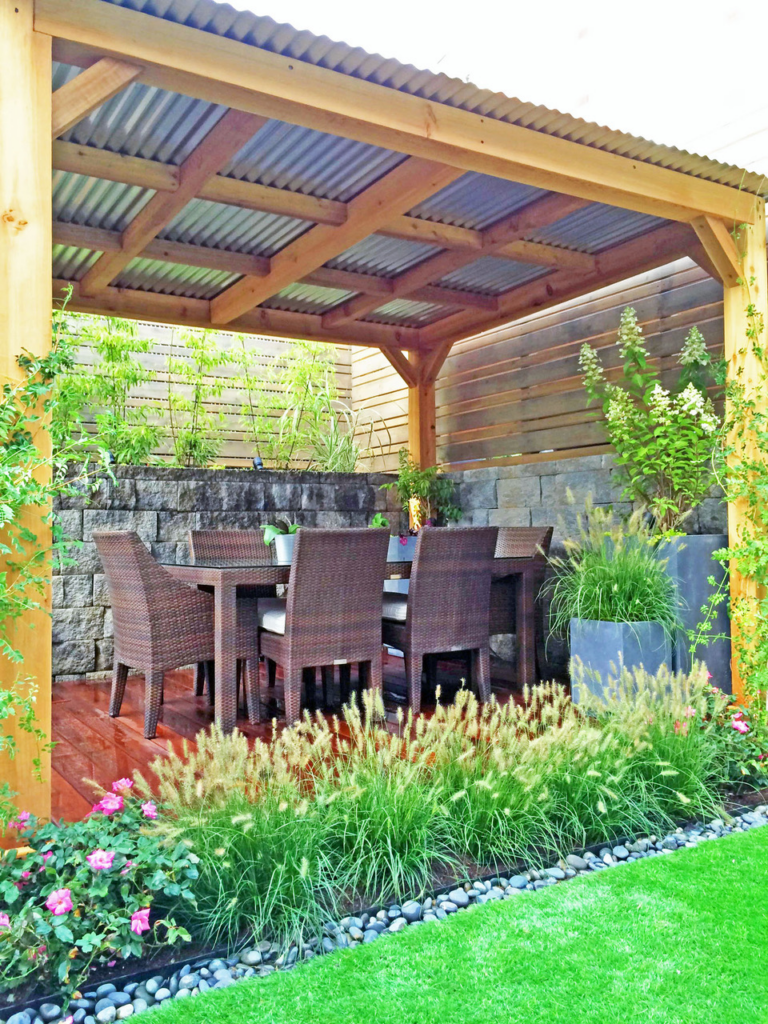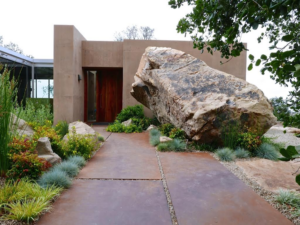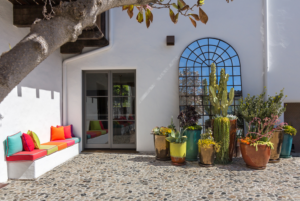Landscaping Idea: Improve Your Backyard Retreat

Landscaping Idea: Our goal in the spring and summer is to spend as much time as possible outside, weather permitting. So, if your outdoor space, whether it’s a wild backyard, a rooftop terrace, or a pot-filled patio, needs a little sprucing up after the long winter. Now is the time to get your hands dirty. But, before you go out to your local nursery and start planting, we’ve gathered some garden design ideas from some of the country’s top landscapers. Consider these landscaping guidelines when updating your yard, and then relax and enjoy the great outdoors this season.
Determine What You Want From Your Space
Landscape designers frequently ask the same question when starting a new project: What do you want to get out of your space? This is how you should approach your own yard, whether you’re adding new plant arrangements or starting from scratch. Kathleen Ferguson, based in Los Angeles According to Kathleen Ferguson Landscapes, it is critical to determine whether you want to be an active participant in the landscape or prefer a more passive, visual experience. “Do you enjoy cooking? Do you host large gatherings? Or do you require a more tranquil and reflective environment? “She inquires. “These responses will serve as the springboard for almost every design.”
The goal of New York landscape designer Jacqueline Harrison of Harrison Green’s client for the garden above was to have a space to relax and entertain in the summer. “The client uses the terrace from spring to fall, but she also looks out from her apartment onto it year-round, so it was critical that the garden be interesting 365 days a year,” Harrison says. “Boxwood hedges provide a strong backbone that is evergreen, while river birch trees provide height and shade in the warmer months.” Harrison used Francee Hosta, Jack Frost, white Begonia, and English ivy in the front of the terrace. Which is mostly shaded. They used viburnum, hydrangea, Russian sage, and a silver mound by the deck, interspersed with more boxwood. “We’re viburnum nerds,” says one.
Choose Your Aesthetic
Terremoto’s David Godshall leans toward the former. “We prefer native, wilder gardens,” he says. “While the composition is always important, minimalist landscapes are a little less exciting to us.” He enjoys it when there is always something in bloom and birds migrate from plant to plant. “The Los Angeles garden (above) is a layered world of Mediterranean, native, and Old Hollywood plants,” he explains. These unusual juxtapositions add interesting energy. There’s just more movement and change we like movement and change.” Honeybush, Australian tree fern, Cleveland sage, artichokes, fox tail agave, and French lavender make up the plants.

If you’re looking for something sleeker and more modern, you might be drawn to Amber Freda Landscape Design’s Brooklyn backyard above. Freda’s biggest challenge in this project was figuring out how to combine various elements in a way that felt very modern and streamlined. “The owner of this townhouse is a Texas native, and she missed the sound of rain on the tin roofs there,” she says. “We wanted plants that looked lush and inviting while also complementing the contemporary theme.” She chose grasses, cherry trees, bamboo, roses, trumpet vines, variegated irises, hydrangeas, and other plants

Recognize the Climate
Understanding how much sunlight your garden receives, as well as the local climate, is critical to designing a successful landscape no matter where you live. “We have many different microclimates in Southern California, which allows for a diverse range of species, from exotic tropicals to arid desert species. With so many options, we can constantly experiment with new concepts “Ferguson claims.
She also believes that the best gardens are strategic. “One must explore the hidden opportunities within each landscape,” she says, noting that climate and native elements also play a role. “Try using materials you have on-site in unexpected ways.” For the Santa Barbara project above she relocated a large boulder on the property to make a very bold entry and used drought tolerant plants like sage, coffeeberry, and blue fescue grass. “If it was a more shady site, we might select low light species with variegation or lighter green foliage to visually lighten up the area, like a golden variegated sweet flag and coral bells.”
If you’re lucky enough to have an outdoor space in a city, it’s usually on a roof rather than in a backyard—which brings with it a whole new set of considerations. “Gardening on a roof is similar to gardening on top of a mountain,” Freda says. “You want things that aren’t too top-heavy and don’t have really large leaves that could get shredded up in the wind,” says the expert. She suggests low-maintenance plants, such as grasses, evergreens, and deciduous trees, which can thrive in these conditions with minimal care. Freda chose coral bark maples, hornbeams, pink cherry trees, crape myrtles, and feather grasses for this Manhattan rooftop.
Pro tip:
“When it comes to city gardens, particularly sunny roof gardens and terraces, drip irrigation systems are a must,” Freda advises. “Container plants require more water than ground plants and should be watered once or twice a day in the summer. Drip irrigation ensures accurate, thorough watering, which reduces the need to spend money on replacement plants each year.”
Choose Texture
“We like green gardens,” Harrison says. “Flowers fade, but foliage lasts forever.” Her team prioritizes the quality of the foliage over the quality of the flower. It’s all about finding the right shade of green for your garden and adding texture. When they do use color, it is typically in cool tones or white. Godshall agrees that texture is important: “It’s about putting things together and creating interesting contrasts and moments,” he explains. “We consider texture, color, and structure before putting them together in interesting ways.” He chose boxwood hedges, rhododendron, Alsophila australis, white roses, and an apple tree for the San Francisco garden shown above.
If you like flowers, Freda suggests flowering annuals for clients who don’t mind replanting them every year. She recommends easy-to-maintain ones for those who live in more urban areas. “We adore quickfire hydrangeas and knockout roses because of their long bloom times, versatility, and pest resistance,” she says.”We absolutely adore quickfire hydrangeas and knockout roses for their long bloom times, versatility, and pest resistance,” she says.

Choose Pots and Simple Plants
Ferguson recommends using pots and containers as “landscape accessories” if your backyard has a lot of cement, patio, or hardscape. On the terrace of the above Los Angeles home, she demonstrates this with cactus and an assortment of succulents in brightly colored pots. Although all plants can be grown in pots or planters, these are excellent low-maintenance choices. “We consider succulents to be the easiest plants to care for because they thrive in a variety of environments with little care,” Ferguson says.
Cactus also do not require irrigation and require very little maintenance. Freda likes to do a row of straight-lined shapes against round shapes like ceramic pots to help break up the lines and create contrast. What should you plant in them? She prefers grasses, bamboo, small deciduous trees, medium to small flowering shrubs, and most small-leaf evergreens because they are low-maintenance.
FAQ
How can I make my backyard more appealing?
- Image search results for These Beautiful Landscaping Ideas Will Enhance Your Backyard Retreat Your Budget-Friendly Backyard Makeover Guide
- Make your own deck or patio. … Lay Down an Outdoor Rug (Photo by @seekingalexi). Photo credit: @alexandmike … Make a stone path. Photo credit: @plaids.and.poppies
- Build a Tree Bench…. Install a Trellis…. Add Shade with a Pergola…. Purchase a Fountain…. Use a Stock Tank Pool.
How much does landscaping add to the value of a home?
According to a Virginia Tech study, landscaping not only improves curb appeal but also increases the value of real estate properties by 15%. The study discovered that plant size, type, and design in landscaping affect the perceived value of a home.
Will landscaping increase the value of my home?
The American Society of Landscape Architects (ASLA) recommends that you invest 10% of the value of your home in landscaping. According to other studies, spending the equivalent percentage on landscape maintenance and upgrades can increase the value of your home by 5% to 15%.
What is the first step in landscaping?
Begin at home and work your way out. Plan for the mature size of the trees and shrubs to avoid having to relocate them later when they outgrow their space! Planting deciduous shrubs in front of evergreens will change the look seasonally.
Leave a Reply
You must be logged in to post a comment.